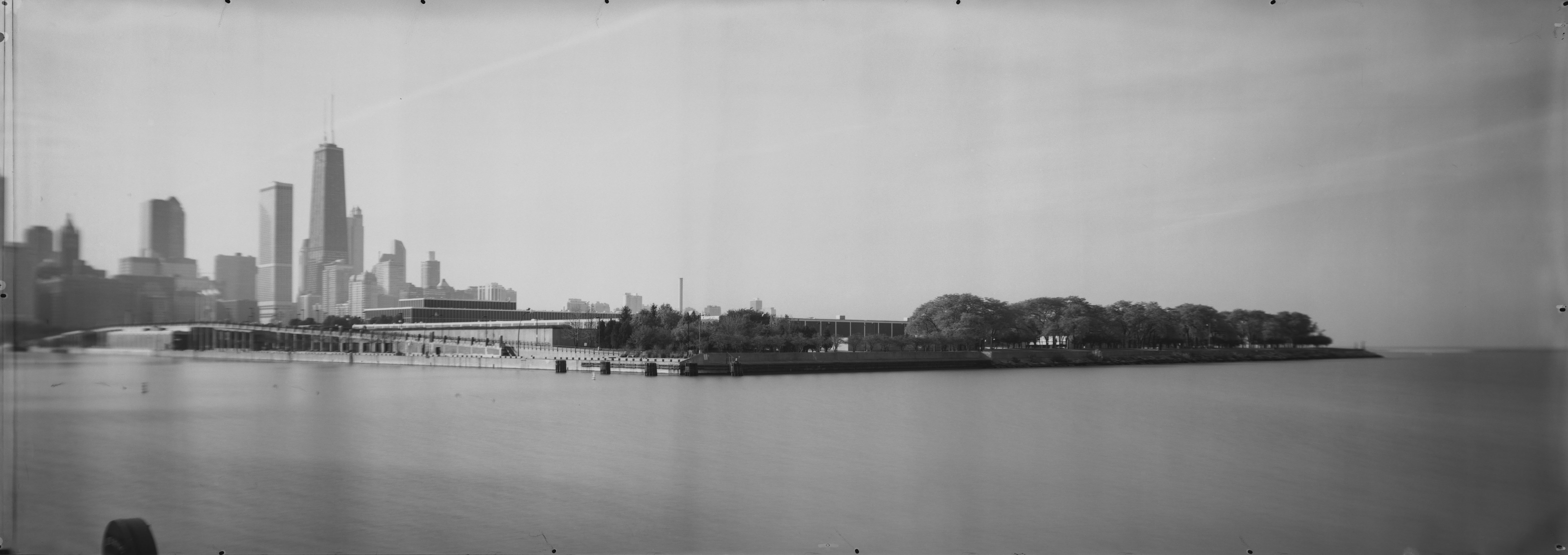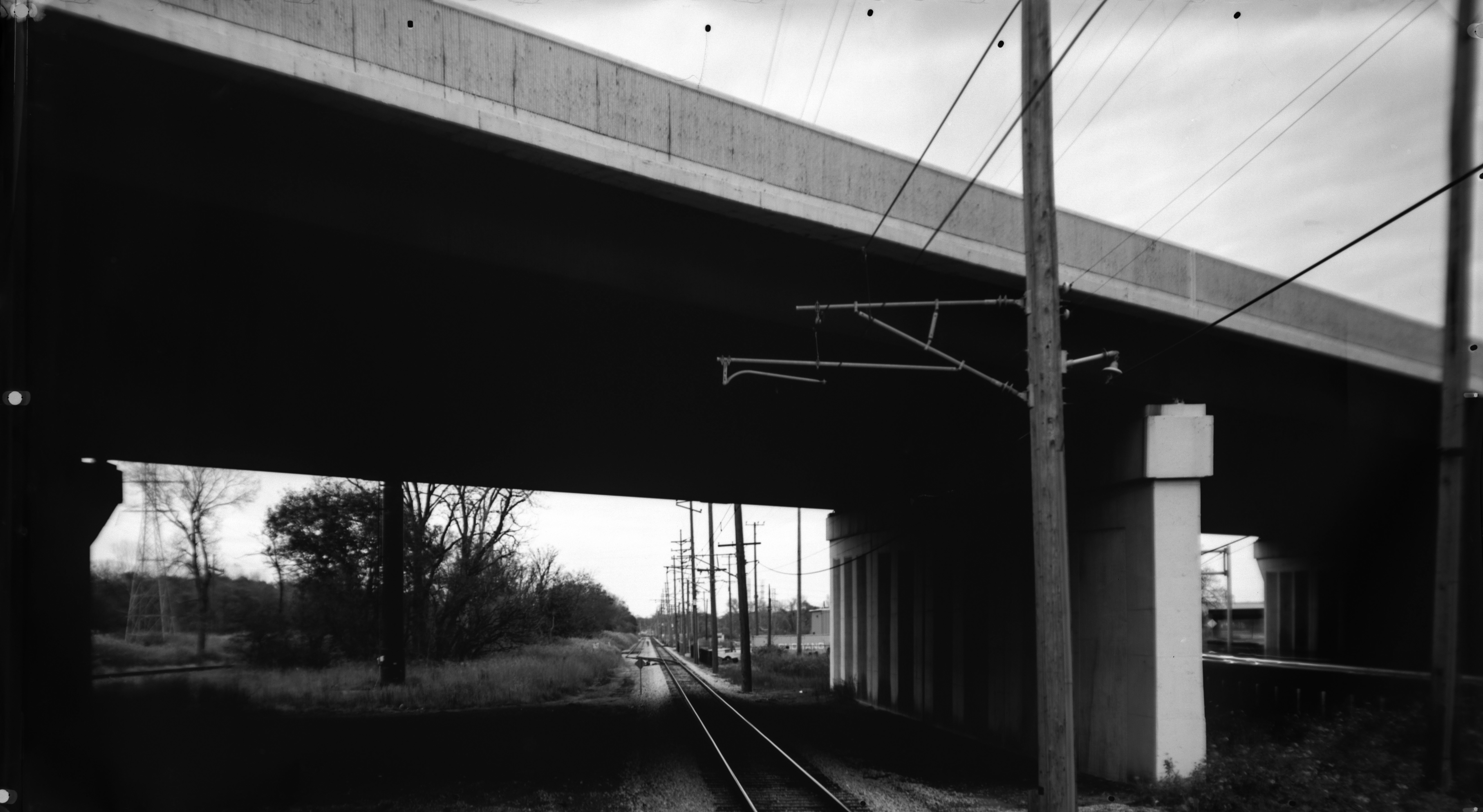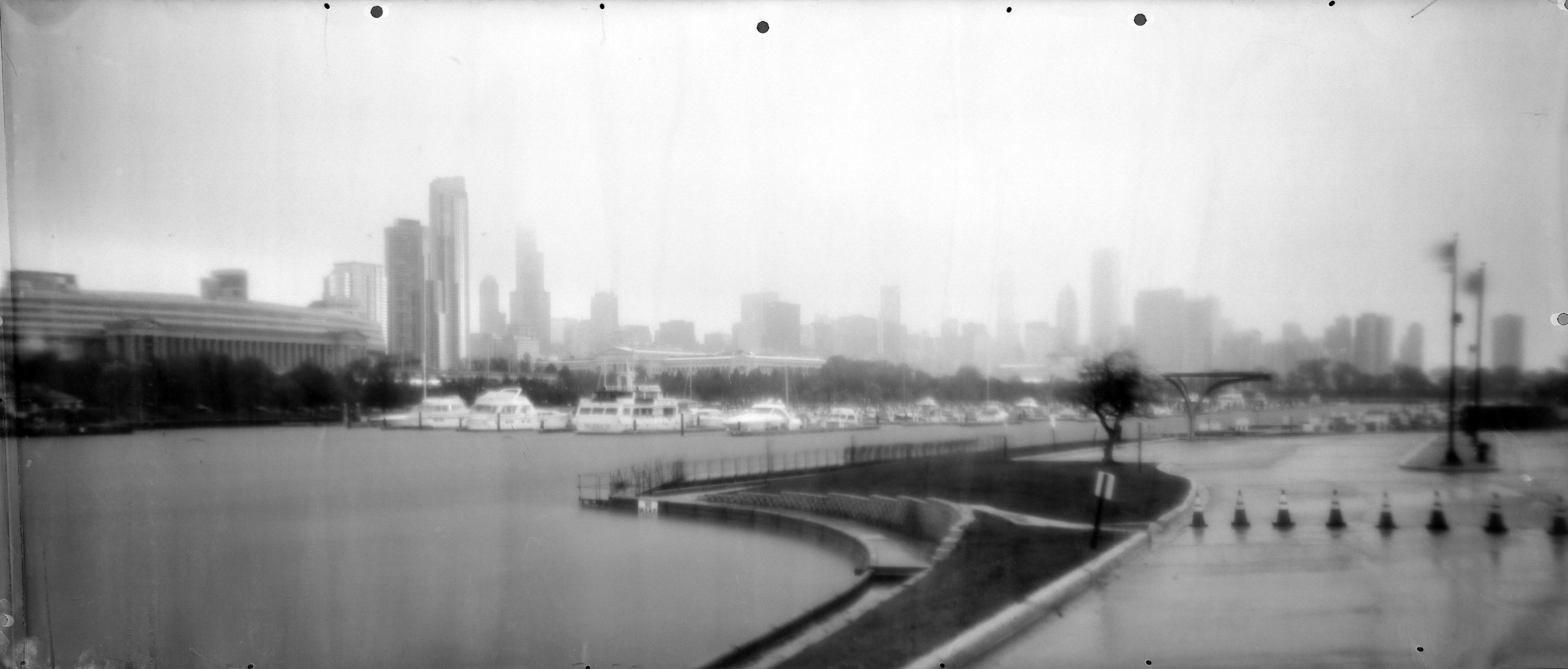 This photo of the Chicago skyline called “Jardine Water Treatment Plant” was taken on Oct. 24, 2014 and is part of the upcoming exhibition, “Liminal Infrastructure” at DePaul Art Museum. Opening May 14, the photographs on display were taken with one of the largest pinhole cameras, the Liminal Camera, by artists from the Optics Division of Metabolic Studio. (Photo courtesy of Metobolic Studio)
This photo of the Chicago skyline called “Jardine Water Treatment Plant” was taken on Oct. 24, 2014 and is part of the upcoming exhibition, “Liminal Infrastructure” at DePaul Art Museum. Opening May 14, the photographs on display were taken with one of the largest pinhole cameras, the Liminal Camera, by artists from the Optics Division of Metabolic Studio. (Photo courtesy of Metobolic Studio)CHICAGO — A massive shipping container rolled through Chicago last fall, but instead of carrying cargo, it was taking stunning photographs of the city and its surrounding waterways.
The resulting images are part of the exhibition, “Liminal Infrastructure,” that will be on display at the DePaul Art Museum beginning May 14. Organized in collaboration with the Chicago Humanities Festival, the photographs were created using one of the world’s largest pinhole cameras, the Liminal Camera, by artists Lauren Bon, Richard Nielsen and Tristan Duke during their exploration of the Great Lakes region last October.
“The Liminal Camera breaks down the photographic process to its most basic and raw elements,” said Greg Harris, curator of the exhibition. “It makes people step back and think about how photographs originally came into the world, and that is really important in a time when our lives are inundated and saturated with digital images.”
 “Infrastructure Gary Indiana” shows a region that is highly dependent on railroads as a means of transportation for people and goods. It was taking on Oct. 30, 2014 and is part of the upcoming exhibition, “Liminal Infrastructure” at DePaul Art Museum. Opening May 14, the photographs on display were taken with one of the largest pinhole cameras, the Liminal Camera, by artists from the Optics Division of Metabolic Studio. (Photo courtesy of Metobolic Studio)
“Infrastructure Gary Indiana” shows a region that is highly dependent on railroads as a means of transportation for people and goods. It was taking on Oct. 30, 2014 and is part of the upcoming exhibition, “Liminal Infrastructure” at DePaul Art Museum. Opening May 14, the photographs on display were taken with one of the largest pinhole cameras, the Liminal Camera, by artists from the Optics Division of Metabolic Studio. (Photo courtesy of Metobolic Studio)The exhibition will include large-scale photographs of the Chicago landscape, measuring up to 8 feet on the longest side, according to Harris. The dramatic proportions are uniquely suited for extreme horizontal and vertical photos. Perfect for the prairie city that gave birth to the skyscraper, he said.
The photos on display are part of the latest chapter of the Liminal Camera’s expedition across the Great Lakes region. During the Chicago Humanities Festival last fall, the artists invited people inside the Liminal Camera to experience the camera obscura technique in action and to see how they perform the photographic process.
The technique involves fashioning a hole on the side of a darkened box to produce images inside of it. It’s a centuries-old practice that led to the creation of photography and the modern camera. When the image is projected in the box, a photograph can be made when that image is transferred to photographic paper and processed in a darkroom.
Anticipating the need to make the Liminal Camera portable for their expedition, the artists made the shipping container completely self-sustained; it produces its own solar energy and even doubles as a darkroom.
Since 2010, the artists, who are part of the Optics Division of the Los Angeles-based Metabolic Studio, have canvased the continent to document issues of water resources from the dry West to New York’s waterways. The topic is pertinent to Chicago since it is built around waterways, and reliant on a network of transportation that moves around water. “Even for those who are familiar with the city of Chicago, ‘Liminal Infrastructure’ is a truly unexpected and rare way for people to see the city’s infrastructure and historic locales,” said Harris.
 This photo of a stormy Chicago skyline called “Storm from Northerly Island (Nick's Shot)” was taken on Oct. 31, 2014 and is part of the upcoming exhibition, “Liminal Infrastructure” at DePaul Art Museum. Opening May 14, the photographs on display were taken with one of the largest pinhole cameras, the Liminal Camera, by artists from the Optics Division of Metabolic Studio. (Photo courtesy of Metobolic Studio)
This photo of a stormy Chicago skyline called “Storm from Northerly Island (Nick's Shot)” was taken on Oct. 31, 2014 and is part of the upcoming exhibition, “Liminal Infrastructure” at DePaul Art Museum. Opening May 14, the photographs on display were taken with one of the largest pinhole cameras, the Liminal Camera, by artists from the Optics Division of Metabolic Studio. (Photo courtesy of Metobolic Studio)On May 14 at 4:30 p.m., the artists will recount their experience and unveil the photographs they took with the Liminal Camera in and around Chicago last fall. A public reception will follow beginning at 5:30 p.m. The event is part of the Chicago Humanities Festival 2015 spring schedule and is free and open to the public. For more information visit http://bit.ly/CHF15.
“Liminal Infrastructure” will be on display at the DePaul Art Museum May 14-Aug. 9.
Also on display at the DePaul Art Museum will be artist Sonja Thomsen’s “Glowing Wavelengths In Between,” May 14-Aug. 9. In her exhibition, Thomsen utilizes an array of materials that refract and reflect light as means to creative discovery. The resulting pieces are vibrant color photographs, immersive photographic murals and faceted metallic sculptures. Thomsen’s layered works create an interactive experience for the viewer that provokes an awareness of light, space and time.
The DePaul Art Museum at 935 W. Fullerton, just east of the CTA’s Fullerton ‘L’ stop, is open Wednesday and Thursday from 11 a.m. to 7 p.m., Friday from 11 a.m. to 5 p.m., and Saturday and Sunday from noon to 5 p.m. The museum is closed Mondays and Tuesdays. For more on the DePaul Art Museum’s upcoming exhibitions and events, call 773-325-7506 or visit http://bit.ly/DPAM15.
###
Media Contact:
Wendy Zamaripa Smit
wsmit@depaul.edu
312-362-7749
DePaul Art Minute - Liminal Infrastructure